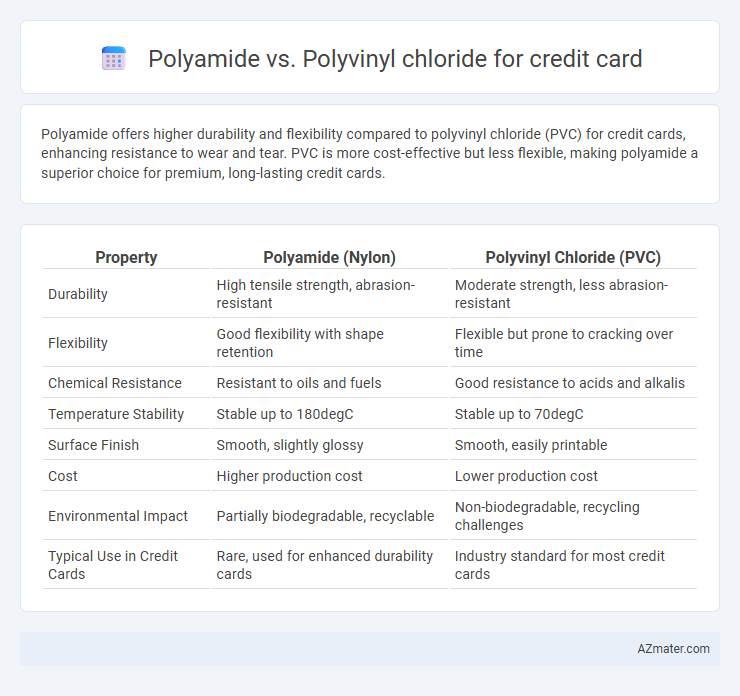Polyamide offers higher durability and flexibility compared to polyvinyl chloride (PVC) for credit cards, enhancing resistance to wear and tear. PVC is more cost-effective but less flexible, making polyamide a superior choice for premium, long-lasting credit cards.
Table of Comparison
| Property | Polyamide (Nylon) | Polyvinyl Chloride (PVC) |
|---|---|---|
| Durability | High tensile strength, abrasion-resistant | Moderate strength, less abrasion-resistant |
| Flexibility | Good flexibility with shape retention | Flexible but prone to cracking over time |
| Chemical Resistance | Resistant to oils and fuels | Good resistance to acids and alkalis |
| Temperature Stability | Stable up to 180degC | Stable up to 70degC |
| Surface Finish | Smooth, slightly glossy | Smooth, easily printable |
| Cost | Higher production cost | Lower production cost |
| Environmental Impact | Partially biodegradable, recyclable | Non-biodegradable, recycling challenges |
| Typical Use in Credit Cards | Rare, used for enhanced durability cards | Industry standard for most credit cards |
Introduction to Polyamide and Polyvinyl Chloride in Credit Cards
Polyamide, commonly known as nylon, offers high mechanical strength, durability, and resistance to abrasion, making it ideal for credit card substrates requiring flexibility and impact resistance. Polyvinyl chloride (PVC) is widely used in credit card manufacturing due to its excellent printability, chemical resistance, and low production cost, providing a rigid and smooth surface for reliable card functionality. Comparing the two, polyamide ensures enhanced durability and flexibility, while PVC remains the industry standard for affordable, high-quality credit card production.
Material Composition and Properties Comparison
Polyamide, known for its high tensile strength and flexibility, offers excellent thermal resistance and durability, making it suitable for credit cards requiring long-term wear and structural integrity. Polyvinyl chloride (PVC) exhibits superior chemical resistance, lower cost, and ease of printing, which translates into widespread industry usage despite its comparatively lower flexibility and potential environmental concerns. The material composition of polyamide features repeating amide linkages providing robust mechanical properties, whereas PVC consists of vinyl chloride monomers contributing to its rigidity and weather resistance.
Durability: Polyamide vs Polyvinyl Chloride
Polyamide offers superior durability compared to polyvinyl chloride (PVC) for credit cards, exhibiting greater resistance to abrasion, temperature variations, and chemical exposure. PVC tends to become brittle and prone to cracking over time, especially under extreme environmental conditions, whereas polyamide maintains flexibility and structural integrity. This enhanced mechanical robustness makes polyamide an optimal choice for long-lasting, high-performance credit cards.
Flexibility and Wear Resistance
Polyamide demonstrates superior flexibility compared to polyvinyl chloride, allowing credit cards to withstand bending and twisting without cracking. Its enhanced wear resistance contributes to longer-lasting cards that resist surface scratches and abrasion during frequent use. Polyvinyl chloride, while commonly used, tends to be more rigid and prone to surface degradation, making polyamide a better choice for durable, flexible credit cards.
Security Features Compatibility
Polyamide offers enhanced security features for credit cards through its superior durability and resistance to tampering, making it compatible with advanced biometric and RFID technologies. Polyvinyl chloride (PVC), while widely used due to cost-effectiveness and ease of printing, is more susceptible to wear and fraud attempts, limiting its integration with high-security features. The compatibility of polyamide with embedded chips and holograms ensures improved protection against counterfeiting compared to traditional PVC cards.
Environmental Impact and Sustainability
Polyamide credit cards generate less environmental impact due to their biodegradability and recyclability compared to polyvinyl chloride (PVC), which is derived from non-renewable fossil fuels and releases toxic chemicals such as dioxins during production and disposal. PVC's persistent environmental pollution and challenges in recycling contribute significantly to landfill accumulation and long-term ecological harm. Polyamide offers a more sustainable alternative by reducing carbon footprint and facilitating eco-friendlier end-of-life processing.
Cost Efficiency and Manufacturing Processes
Polyamide offers higher durability and flexibility compared to polyvinyl chloride (PVC), but PVC remains more cost-efficient due to lower raw material and processing expenses. Manufacturing polyamide credit cards involves more complex extrusion and molding techniques, increasing production time and costs relative to the simpler PVC lamination processes. PVC's widespread use in the credit card industry is driven by its balance of affordability and ease of manufacturing, despite polyamide's superior mechanical properties.
Printing Quality and Customization Options
Polyamide offers superior printing quality for credit cards due to its smooth surface and excellent ink adhesion, resulting in sharper images and vibrant colors. In contrast, Polyvinyl chloride (PVC) provides good printability but may exhibit slight ink smudging or fading over time, especially under frequent use. Customization options with Polyamide include advanced embossing and tactile finishes, whereas PVC supports a wider range of color variations and cost-effective personalization techniques.
Market Trends and Adoption Rates
Polyamide exhibits growing adoption in credit card manufacturing due to its superior durability and flexibility compared to polyvinyl chloride (PVC), which remains dominant but faces declining usage amid environmental concerns. Market trends indicate a shift towards sustainable materials, with polyamide gaining traction for its recyclability and resilience under frequent use. Adoption rates reveal industries prioritizing polyamide for premium and eco-friendly cards, reflecting a broader move toward reducing PVC reliance in the payment card sector.
Conclusion: Best Choice for Credit Card Production
Polyamide offers superior flexibility, durability, and wear resistance compared to polyvinyl chloride, making it ideal for credit card production where longevity is crucial. Polyvinyl chloride provides excellent printability and cost-efficiency but tends to be less resistant to cracking and environmental stress over time. For high-quality, durable credit cards, polyamide is the best choice due to its enhanced mechanical properties and longer lifespan.

Infographic: Polyamide vs Polyvinyl chloride for Credit card
 azmater.com
azmater.com